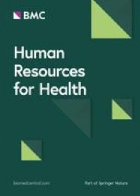About us
Health systems can only function with health workers; improving health service coverage and realizing the right to the enjoyment of the highest attainable standard of health is dependent on their availability, accessibility, acceptability and quality.
WHO estimates a projected shortfall of 11.1 million health workers by 2030 (1), mostly in low- and lower-middle income countries. However, countries at all levels of socioeconomic development face, to varying degrees, difficulties in the education, employment, deployment, retention, and performance of their workforce.
The chronic under-investment in education and training of health workers in some countries and the mismatch between education and employment strategies in relation to health systems and population needs are contributing to continuous shortages. These are compounded by difficulties in deploying health workers to rural, remote and under-served areas. Moreover, the increasing international migration of health workers may exacerbate health workforce shortfalls, particularly in low- and lower-middle income countries.
In some countries, challenges in universal access to health workers may also result from the lack of fiscal space to absorb the supply of health workers. As a result, some countries face the paradox of health worker unemployment co-existing with major unmet health workforce needs.
The High-Level Commission on Health Employment and Economic Growth found that investments in the health and social workforce can spur inclusive economic growth. The health workforce has also a vital role in building the resilience of communities and health systems and in emergency preparedness and response. Approximately 67% of the health workforce are women: investing in the health workforce is an opportunity to create decent employment opportunities, in particular for women and youth.
Our Team
All->Our work
News
External publications

Quality of care provided by mid-level health workers: systematic review and meta-analysis
Objective To assess the effectiveness of care provided by mid-level health workers.

Monitoring the implementation of the WHO Global Code of Practice on the International Recruitment of...
Objective To present the findings of the first round of monitoring of the global implementation of the WHO Global Code of Practice on the International...

Health worker remuneration in WHO Member States
Objective To present the available data on the money spent by Member States of the World Health Organization (WHO) on remunerating health workers in...

Funding, flexible management needed for Brazil’s health worker gaps
Last month the first Cuban physicians arrived in Brazil under a new government programme to work in underserved parts of the country, both rural and urban....

More midwives needed to improve maternal and newborn survival
Retention of midwives, especially in rural areas, is a major challenge for many countries, one that threatens to negate all the hard work and resources...

Public health round-up
World Health Organization (WHO) experts will join their colleagues from health and environment nongovernmental organizations at a Climate and Health Summit...

Beyond clinical skills: key capacities needed for universal health coverage
Global commitment to achieving universal health coverage (UHC) has grown stronger in recent years. With this commitment has come the realization that,...

Human resources for universal health coverage: leadership needed
Global leaders have recently reaffirmed their commitment to the principle of universal health coverage (UHC). The experience of the health-related Millennium...

Investing in human resources for health: the need for a paradigm shift
Development partner strategies and support in the area of human resources for health (HRH) have been shaped by key reports and events over the past decade....

Human resources for universal health coverage: from evidence to policy and action
The seminal role of human resources for health (HRH) in the attainment of health-related goals has long been recognized and was recently reaffirmed by...

Correct interpretation of the WHO health workforce support and safeguards list 2023
The Support and Safeguards List identifies countries that should be prioritized for health workforce support by governments and the international community,...

The roles and involvement of global health partners in the health workforce: an exploratory analysis
Development partners and global health initiatives are important actors in financing health systems in many countries. Despite the importance of the health...
Events
Call for consultation
Normative publications
The Expert Advisory Group on the Global Code of Practice on the International Recruitment of Health Personnel (the Code) recommended that countries with...
The review of relevance and effectiveness of the WHO Global Code of Practice on the International Recruitment of Health Personnel takes place through a...
This thematic brief accompanies the Working for Health 2022–2030 Action Plan, serving as a background and rationale to the related actions of the...
This thematic brief accompanies the Working for Health 2022–2030 Action Plan, serving as a rationale to the related actions of the Working for Health...
Additional publications
Classifying health workers
Delivered by Women, Led by Men: A Gender and Equity Analysis of the Global Health and Social Workforce
Lancet Global Health: Health policy and system support to optimise community health worker programmes: an abridged WHO guideline
GHWN Strategic Advisory Committee Members/Bios
Web annex: WHO guideline on health policy and system support to optimize community health worker programmes
Working for Health - Expanding and transforming the health and social workforce for the Sustainable Development Goals
Health topics
Related teams

